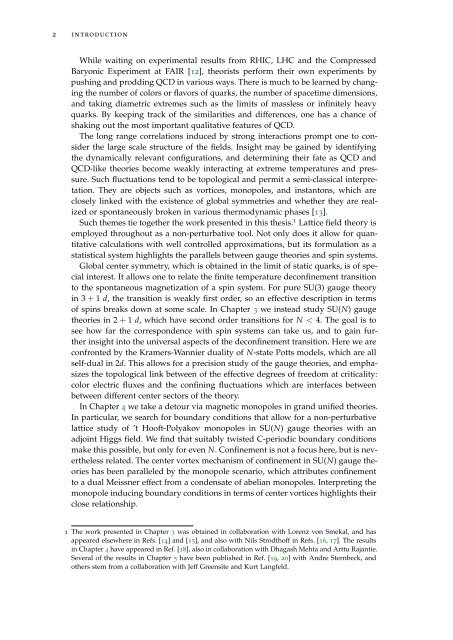Topology, symmetry, and phase transitions in lattice gauge ... - tuprints
Topology, symmetry, and phase transitions in lattice gauge ... - tuprints
Topology, symmetry, and phase transitions in lattice gauge ... - tuprints
Create successful ePaper yourself
Turn your PDF publications into a flip-book with our unique Google optimized e-Paper software.
2 <strong>in</strong>troduction<br />
While wait<strong>in</strong>g on experimental results from RHIC, LHC <strong>and</strong> the Compressed<br />
Baryonic Experiment at FAIR [12], theorists perform their own experiments by<br />
push<strong>in</strong>g <strong>and</strong> prodd<strong>in</strong>g QCD <strong>in</strong> various ways. There is much to be learned by chang<strong>in</strong>g<br />
the number of colors or flavors of quarks, the number of spacetime dimensions,<br />
<strong>and</strong> tak<strong>in</strong>g diametric extremes such as the limits of massless or <strong>in</strong>f<strong>in</strong>itely heavy<br />
quarks. By keep<strong>in</strong>g track of the similarities <strong>and</strong> differences, one has a chance of<br />
shak<strong>in</strong>g out the most important qualitative features of QCD.<br />
The long range correlations <strong>in</strong>duced by strong <strong>in</strong>teractions prompt one to consider<br />
the large scale structure of the fields. Insight may be ga<strong>in</strong>ed by identify<strong>in</strong>g<br />
the dynamically relevant configurations, <strong>and</strong> determ<strong>in</strong><strong>in</strong>g their fate as QCD <strong>and</strong><br />
QCD-like theories become weakly <strong>in</strong>teract<strong>in</strong>g at extreme temperatures <strong>and</strong> pressure.<br />
Such fluctuations tend to be topological <strong>and</strong> permit a semi-classical <strong>in</strong>terpretation.<br />
They are objects such as vortices, monopoles, <strong>and</strong> <strong>in</strong>stantons, which are<br />
closely l<strong>in</strong>ked with the existence of global symmetries <strong>and</strong> whether they are realized<br />
or spontaneously broken <strong>in</strong> various thermodynamic <strong>phase</strong>s [13].<br />
Such themes tie together the work presented <strong>in</strong> this thesis. 1 Lattice field theory is<br />
employed throughout as a non-perturbative tool. Not only does it allow for quantitative<br />
calculations with well controlled approximations, but its formulation as a<br />
statistical system highlights the parallels between <strong>gauge</strong> theories <strong>and</strong> sp<strong>in</strong> systems.<br />
Global center <strong>symmetry</strong>, which is obta<strong>in</strong>ed <strong>in</strong> the limit of static quarks, is of special<br />
<strong>in</strong>terest. It allows one to relate the f<strong>in</strong>ite temperature deconf<strong>in</strong>ement transition<br />
to the spontaneous magnetization of a sp<strong>in</strong> system. For pure SU(3) <strong>gauge</strong> theory<br />
<strong>in</strong> 3 + 1 d, the transition is weakly first order, so an effective description <strong>in</strong> terms<br />
of sp<strong>in</strong>s breaks down at some scale. In Chapter 3 we <strong>in</strong>stead study SU(N) <strong>gauge</strong><br />
theories <strong>in</strong> 2 + 1 d, which have second order <strong>transitions</strong> for N < 4. The goal is to<br />
see how far the correspondence with sp<strong>in</strong> systems can take us, <strong>and</strong> to ga<strong>in</strong> further<br />
<strong>in</strong>sight <strong>in</strong>to the universal aspects of the deconf<strong>in</strong>ement transition. Here we are<br />
confronted by the Kramers-Wannier duality of N-state Potts models, which are all<br />
self-dual <strong>in</strong> 2d. This allows for a precision study of the <strong>gauge</strong> theories, <strong>and</strong> emphasizes<br />
the topological l<strong>in</strong>k between of the effective degrees of freedom at criticality:<br />
color electric fluxes <strong>and</strong> the conf<strong>in</strong><strong>in</strong>g fluctuations which are <strong>in</strong>terfaces between<br />
between different center sectors of the theory.<br />
In Chapter 4 we take a detour via magnetic monopoles <strong>in</strong> gr<strong>and</strong> unified theories.<br />
In particular, we search for boundary conditions that allow for a non-perturbative<br />
<strong>lattice</strong> study of ’t Hooft-Polyakov monopoles <strong>in</strong> SU(N) <strong>gauge</strong> theories with an<br />
adjo<strong>in</strong>t Higgs field. We f<strong>in</strong>d that suitably twisted C-periodic boundary conditions<br />
make this possible, but only for even N. Conf<strong>in</strong>ement is not a focus here, but is nevertheless<br />
related. The center vortex mechanism of conf<strong>in</strong>ement <strong>in</strong> SU(N) <strong>gauge</strong> theories<br />
has been paralleled by the monopole scenario, which attributes conf<strong>in</strong>ement<br />
to a dual Meissner effect from a condensate of abelian monopoles. Interpret<strong>in</strong>g the<br />
monopole <strong>in</strong>duc<strong>in</strong>g boundary conditions <strong>in</strong> terms of center vortices highlights their<br />
close relationship.<br />
1 The work presented <strong>in</strong> Chapter 3 was obta<strong>in</strong>ed <strong>in</strong> collaboration with Lorenz von Smekal, <strong>and</strong> has<br />
appeared elsewhere <strong>in</strong> Refs. [14] <strong>and</strong> [15], <strong>and</strong> also with Nils Strodthoff <strong>in</strong> Refs. [16, 17]. The results<br />
<strong>in</strong> Chapter 4 have appeared <strong>in</strong> Ref. [18], also <strong>in</strong> collaboration with Dhagash Mehta <strong>and</strong> Arttu Rajantie.<br />
Several of the results <strong>in</strong> Chapter 5 have been published <strong>in</strong> Ref. [19, 20] with Andre Sternbeck, <strong>and</strong><br />
others stem from a collaboration with Jeff Greensite <strong>and</strong> Kurt Langfeld.
















